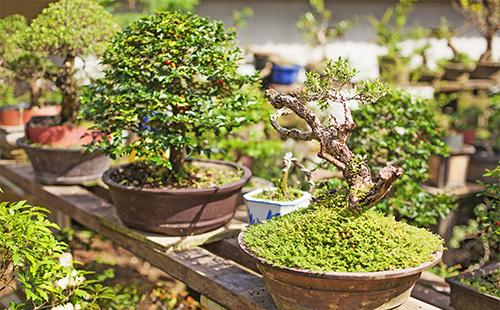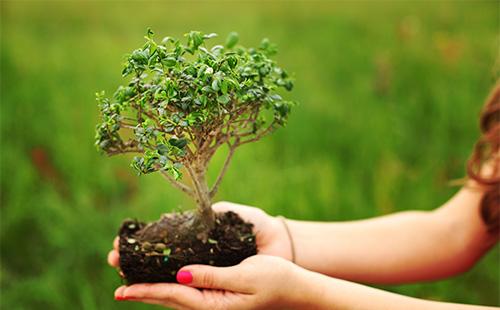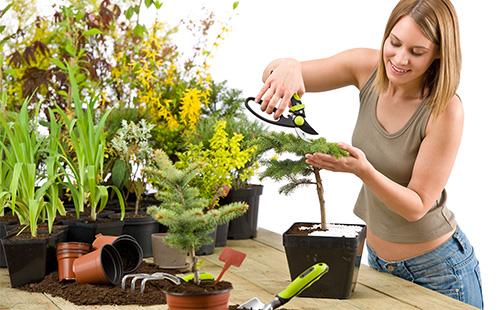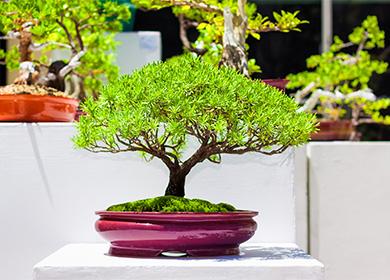The content of the article
The popularity of bonsai is constantly growing. Small bizarre trees look stylish and unusual. Their formation is delayed for years, but the result is worth the time spent and effort.
A Brief Description of Japanese Art
Bonsai are not genetically dwarf plants. Trees and shrubs are given a miniature appearance by constant formation - pinching, pruning, applying wire. The goal of all these procedures is to redistribute the energy of healthy growth.
Moreover, not only the crown is formed, but also the root system. Almost any plant with a lignified trunk and relatively small leaves can be turned into a banzai. For planting, small bowls and pots are used. Live moss is planted on the surface of the soil.
Plant selection
To form almost any lignified culture in the bonsai style. But not all plants are equally easy to shape. Two of the most successful: pine and maple. Use very young trees under the age of two to three years.
Plants taken from the forest are called Yamadori. They are beautiful, but need a cold wintering. In winter, they can be kept on a glazed but unheated balcony. Another drawback is slow growth. Here are some of the crops suitable for bonsai formation.
Lignified tropical crops are easier to form, grow faster. The most common bonsai plant is ficus. It is better for beginners to choose species with a short trunk, small leaves and flowers. They are much easier to form in the form of a compact tree. Suitable characteristics are possessed by the following indoor crops:
- myrtle;
- laurel;
- mandarin;
- lemon;
- Muraya;
- thuja;
- hibiscus;
- boxwood;
- figs.
Popular styles
For many years of growing dwarf trees, many styles have been invented. Most of them are natural forms of growth. A total of 13 basic styles.
- Hokidati. Popular fan style. It is used to form crops with long, thin shoots. The trunk is straight from the bottom, vertical.At the top, it branches, forming a spherical crown.
- Tekkan. Standard vertical style. The base of the trunk is thick, gradually tapering to the crown. The tree branches at the crown, forming a lush crown.
- Moyogi. More complex, non-traditional vertical style. The trunk is thickened at the base, tapering to the crown. Its bends resemble the letter S. Branches extend from each bend.
- Syakkan. A tree with a pronounced slope. Under natural conditions, this form is obtained with constant winds or growth in a shaded place. When forming a slope, an angle is maintained up to 80 до relative to the soil. On the opposite side, roots protruding above the ground. The trunk is made even or curved, but necessarily form a thickening at the base.
- Kengai. So called cascading style. First, the tree grows up, then bends down. Direct horizontal branches extend to the side.
- Bungees. If the trees grow closely, they begin to reach up. Moreover, all lower branches lose their leaves and die. The trunk is flat or slightly curved, bare. The branches and leaves are concentrated on the top of the head.
- Fukinagashi. Repeats a tree bent by constant winds. The trunk and branches are tilted in the same direction.
- Secan. A tree with two trunks. They diverge directly from the base or just above it. Crohn in both trunks is on the same level.
- Kabudati. The style does not look like a secant, but differs in a large number of trunks growing from one root system, forming a single crown.
- Yose. Imitation of a whole grove of trees. In random order, several seedlings are planted in one pot at once. The largest trees are located in the center, small ones along the edges.
- Sekoyoyu. Simulates the growth of trees on the rocks. Thick coarse roots braid the stone, then plunge into the soil.
- Ikadabuki. This style copies fallen trees. In a fallen tree, branches begin to grow up, gradually replacing the main trunk. A new root system is being formed. All young trunks have one crown.
- Sarimiki. Under the influence of adverse weather factors, local sections of the bark of trees die off. In bonsai, sections of the bark from the base of the trunk are removed with a knife, bleached with sulfuric lime.
Basis for composition
Adult, well-developed plants are already useless to form. Trimming and shaping work begins early. A young plant will easily tolerate all procedures, will adapt more quickly to cramped growth conditions than an old one. Therefore, the choice of the basis for creating a bonsai must be approached responsibly. There are three ways to obtain a suitable plant.
- Seed cultivation. You can grow bonsai from seed at home. Planting material is purchased in specialized stores. If you plan to create a bonsai from wild trees, the seeds of pine, birch or maple can be collected independently. To germinate a bonsai from seeds, to get strong seedlings, be sure to take into account the requirements for the conditions of the specific culture. The difficulty of growing from seeds is slow growth - you can begin to form at least a year later.
- Growing from the cuttings. From the moment of rooting of the cuttings to obtain a plant suitable for formation, less time passes. Especially if fast-growing crops are used. Initially, efforts are directed to the formation of a strong root system. It will not allow the plant to die during radical pruning of the crown.
- Buying seedlings. Growing a bonsai from a seedling is easiest. You can buy a seedling ready for shaping in a store or take from a forest a young tree - birch, oak, maple, pine. When digging up a seedling, they try to preserve the root system as much as possible.Especially careful should be treated with pine - conifers poorly take root. It is not necessary to start the formation immediately - it will take some time to adapt the plant in a new environment.
Crop to shape
To form a bonsai, to achieve a beautiful tree shape, you will have to study a lot of literature. Each style is created using a special technology, but it necessarily includes procedures such as trimming branches, leaves and roots, shaping with wire.
Crown
The crown is cut to give the desired shape, inhibition of vertical growth. The apical buds begin to grow first. Their removal stops vertical growth, stimulates the development of side shoots. When forming a bonsai tree, this feature is used to narrow the stem to the top or to obtain a beautiful bend.
Carefully monitor the uniformity of crown formation in young trees. The kidneys should be approximately at the same height, symmetrically. Removing extra buds achieve the growth of the desired shoots. Formation begins when the plant releases four to five true leaves.
Bonsai should be trimmed in early spring. After about a month, the seedling is transplanted with pruning. An important rule - the root system should be a "reflection" of the ground, that is, have approximately the same volume. Between the scraps maintain an interval of at least two months.
Roots
During transplantation, pruning of the roots is carried out. The earthen lump is not destroyed - the protruding ends are cut with sharp scissors. The total length is reduced by about a third. After trimming, the roots begin to branch, form a dense lump. As a result, the plant receives more moisture and nutrition. After trimming, you can transplant the bonsai into another pot of a suitable size.
Pruning the main root stimulates the development of thick, superficial roots that increase the stability of the tree in a low pit. But, due to the morbidity, this procedure is valid only for healthy plants with a powerful root network.
If the plant has aerial roots, they are not cut, but sent to the soil in a predetermined position. This is achieved not only the best supply of food and moisture, but also increase the originality of the composition.
Branches
Flowering crops are sheared in the fall, before the dormant period, so as not to impede the laying of flower buds. Mowing the rest of the crops is carried out in winter. All branches are cut strictly to the kidney - each shoot should end with a growth point. Haircut begin with the upper branches. The shoots are cut to the second kidney, leaving four leaves. Six leaves are left at the lower shoots. After growing young branches, pruning is repeated, adhering to the same principle.
For cutting use only sharp sterile instruments. Slices are immediately treated with special mastic. After removal of the apical growth point, it is replaced by one of the lateral shoots - it becomes a new peak. When forming conifers, pruning is replaced by pinching. The procedure is carried out in the spring after the appearance of young buds.
If several powerful branches depart from one point at once, their pruning can lead to the formation of growths. Radical pruning is carried out in a timely manner, while the branches are thin and supple.
There are many subtleties in the art of bonsai. Each situation is considered separately - there are no strict rules on the formation. For example, if one powerful shoot leaves the base of a tree, it can be used to thicken the main trunk.When it reaches the desired thickness, the branch is carefully cut with a special curved tool.
Different methods are used for the formation. In total, four main cropping methods can be distinguished.
- Tweezers. So called pinching the growth point. The tops of new shoots are cut off immediately after they are opened.
- Shoot pruning. It is used to slow down vertical growth, stimulates branching, provides high-quality supply of food to the lower shoots.
- Adjust cropping. Used to give a beautiful silhouette to deciduous, deciduous plants. Remove all unnecessary and deformed branches. It is allowed to trim only non-lignified shoots with subsequent coating of fresh wounds with mastic. The best time for a regulatory haircut is winter.
- Brightening Pruning. Perform for thinning thickened crown. Part of the leaves is cut so that the remaining branches receive more light, and the central part of the crown is not exposed.
Leaves
The procedure for pruning leaves is called defoliation. With its help, the growth of smaller leaves is achieved. Defoliation is used for deciduous crops, performed once a year. All leaves are cut with scissors at the place of their articulation with the root. At the end of the shoot, a couple of leaves are left intact so that the flow of juices is not disturbed. After a few weeks, the growth of new leaves will begin.
The procedure of pruning leaves is performed only on healthy, sufficiently developed plants. A month before the planned pruning of foliage, bonsai are systematically fed with balanced fertilizer. After defoliation, the tree is placed in a slightly shaded place. Exclude exposure to drafts and the sun. The procedure can greatly weaken the plant, therefore, four conditions must be observed.
- Root system. She must be well developed and completely healthy.
- Age. Defoliation is applicable only to adult plants with a well-developed crown.
- Foliage. A densely leafy tree after pruning will be able to develop new buds.
- Conditions of detention. Bonsai is contained at the right humidity, temperature, regular watering and top dressing.

Wire Forming
How to make a bonsai mix formation? Wire winding sets the direction of growth of the main trunk, additional branches and roots. Depending on the style being formed, the wire can be used for individual branches or the whole plant as a whole.
The most common use is copper wire. Before use, it is heated on a fire, immediately immersed in cold water. Aluminum wire does not need additional processing.
They begin to form in the early spring, even before the buds open. If the procedure is performed in the summer, the bonsai is pre-watered well to give flexibility to the branches. First, the lower shoots or the base of the trunk are wrapped. Gradually rise higher.
The direction of the winding also matters. On the right side, the winding is performed clockwise. On the left side - in the opposite direction. A dense winding sometimes gives a side effect - the shoot begins to rotate around its axis. No need to tighten the wire too tight - this will worsen sap flow.
The wrapped branch is bent, fixed in the desired position. The free end of the wire is tied to a trunk, a pot, or special pins are stuck into the ground.
In a fixed position, the tree should remain from one month to six months. The duration of the formation largely depends on the growth rate of the culture. On slowly growing trees, the wire is held for several years. All this time, they carefully monitor the state of the branch.
Young, fast-growing crops with tender bark form neatly. Usually a thicker wire is used, wound freely. This method of formation is less dangerous for the plant.
Ways to thicken the trunk
Bonsai takes on the appearance of an adult tree in miniature when its trunk becomes thick enough. This usually takes a long time. Therefore, flower growers resort to procedures that stimulate thickening of the trunk. There are five ways.
- Natural thickening. A young plant until about the age of five is transplanted annually in larger containers. A fortified plant is planted in a bowl.
- Trunk bending. Young plants with already lignified, but still obedient trunks in the spring bend their hands first in one direction, then in the other. The procedure is repeated every week. Minor barrel damage occurs. In response to the negative mechanical effect, active mass buildup begins.
- Wire wrapping. If a plant is formed with a uniform trunk thickness, its base is tightly wrapped with wire. After fouling with bark, the winding is removed. Gradually thickenings will form on the damaged trunk.
- Wire loop. A dangerous, rarely used method. A wire loop is thrown over the basal neck and tightened. As a result of stagnation of juices, an influx of tissues begins, a thickening of the main trunk occurs.
- Side Saving. This method is applied as far as possible, suitable for specimens with a developed side branch near the base of the trunk. It contributes to natural thickening. The branch is not removed until the end of the formation.

Bonsai Tree Care: General Recommendations
How to care for a bonsai so that it retains the appearance of a miniature tree, and does not turn into an ordinary indoor plant? First of all, you need to take into account the characteristics of a particular culture used to form a bonsai. In addition, there are some subtleties of care.
- Lighting. Most indoor crops used to form bonsai need bright but diffused light. They are not placed in the open sun; they are kept from the east or west side. In winter, extra lighting is available.
- Temperature. In the summer they try to keep bonsai at average room temperature. Excessive heat is highly undesirable. In winter, for tropical crops, maintain a temperature of no higher than 18 ° C, for all others - no higher than 15 ° C. Near open air vents and radiators do not put heating. The negative effects of heat can be partially eliminated by frequent spraying.
- Watering. It is advisable to use soft water for irrigation. In winter, you can pour melt water, in summer - rain. Due to growth in a small tank, moderate, but frequent watering is adhered to. Hardwoods are watered more abundantly than conifers. Some gardeners recommend dipping irrigation. Bonsai is lowered into a basin with warm water, kept until the soil is completely saturated with moisture.
- The soil. Bonsai should not be planted in garden soil or universal soil. A mixture of equal amounts of acadama, lava and pumice is used. All of these substances are sold in specialized bonsai stores.If it is not possible to water the tree often, organics are added to the composition - a well-rotted compost for flowers.
- Transfer. The intervals between transplants depend on the type of tree and the size of the pots. Fast-growing crops are transplanted annually or every two years. For mature, old trees, one transplant every three to five years is enough. On a strict schedule, bonsai are not transplanted. The need to change the pot is determined individually. Every spring, the bonsai is carefully removed from the tank, inspecting the root system. If the roots began to twist along the inner perimeter of the bowl, it's time to transplant.
- Top dressing. Throughout the entire growing season, fertilizers are applied every two to three weeks. For adult plants use balanced mineral top dressing with a minimum nitrogen content.

Common pests
For each individual species of plant, different pests are dangerous. Insects, which according to the observations of flower growers most often infect bonsai, are shown in the table.
Table - Bonsai Pests
| Pest | Manifestations | Methods of struggle |
|---|---|---|
| Plant aphid | - The leaves are deformed, mutated; - the plant is covered with sticky secretions; - soot fungus joins | - Bonsai is treated with a soapy solution; - damaged leaves and shoots are cut off; - spray the tree with a preparation containing permethrin |
| Nematodes | - The root system or the aerial part of the plant is affected; - on the roots and stems thickenings resembling a tumor are formed; - a bonsai throws off leaves, stops in growth, perishes | - Reduce watering; - roots are treated with nematicides; - transplanted bonsai with a complete replacement of the soil; - rearrange in a cool place |
| Scaffold and false scaffold | - Convex brown tubercles appear on the stem; - shoots cease to develop; - leaves fall | - The scabbard is removed with a brush or removed with tweezers; - wipe the lesion with diluted medical alcohol; - sprayed with any insecticide |
| Curly aphid | - There is a thick white fluff; - leaves wither, fade; - young shoots turn white | - Wipe the places of accumulation of insects with alcohol; - sprayed with a drug containing permethrin |
| Spider mite | - A thin web appears; - leaves discolor, dry, fall off | - Rearrange bonsai in a shaded room; - increase humidity; - wipe the affected areas with alcohol; - sprayed with the drug "Actara" |
Frequent diseases
Various diseases cause no less harm to bonsai. Infection occurs through poor-quality soil, pests, from neighboring plants. When the first signs of disease appear, treatment is started. The most common diseases affecting bonsai are shown in the table.
Table - Bonsai Disease
| Disease | Outward manifestation | Treatment |
|---|---|---|
| Rust | - Rusty spots appear on the bark and leaves; - bonsai fades, dies | - Cut the affected leaves, bark, growths; - treated with fungicide |
| Verticillosis | - Leaves unevenly yellow, dry | - Cut and destroy damaged leaves; - transplanted into a new, sterile soil; - treated with systemic fungicide |
| Root rot | - On the trunk and the inner surface of the pot appears a greenish coating; - leaves turn yellow and fall; - roots soften | - Bonsai transplanted with pruned roots to a healthy tissue; - reduce watering; - kept in a well-ventilated place; - watered with systemic fungicides |
| Mildew | - Yellow spots with a grayish fluff appear on the leaves; - the plant is getting dark, dying | - Cut off all affected parts of the plant; - sprayed with fungicide, quarantined |
| Powdery mildew | - A white or grayish coating appears; - the leaves become brown | - Cut the affected leaves; - the plant is sprayed with fungicide |
| White root rot | - The general condition of the plant worsens; - the leaves turn pale, become dull; - roots swell and soften | - Cut damaged roots and wash them with fungicide; - transplanted into new soil |
If you properly care for the bonsai tree, it will retain its decorative and unusual appearance for many years. Since a bonsai is artificially formed, its shape is maintained by systematic pruning. The main requirements for caring for the plant composition are properly composed soil, a suitable pot and a well-thought-out watering regime.

